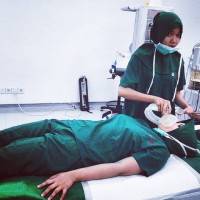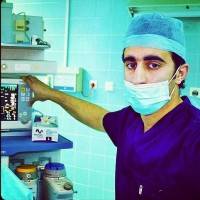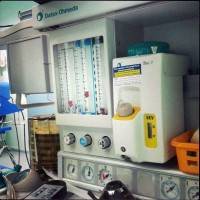Sedation During Rhinoplasty
Go For General Anesthesia For Septorhinoplasties
Every surgeon and anesthesiologists has their own opinions, and there is not a “right” answer to your question.
Nevertheless, I would recommend general anesthesia to my patients considering nasal surgery.
With a breathing tube in place, the anesthesiologist and I don’t have to be quite as worried about the patient’s ventilation, oxygenation, and comfort.
Nowadays, general anesthesia is so safe, I would recommend it for all of my patients undergoing nasal surgery. (Michael C. Pickart, MD, Ventura Plastic Surgeon)
Twilight Sedation for Rhinoplasty
General anaesthesia usually implies that you will have a breathing tube in your lungs which is attached to a ventilator and breathes for you.
As you can imagine you have to be well sedated so you don’t gag on the tube. It also means that probably you will be given inhalation anesthesia to keep you sleeping.
Inhalational gases tend to get absorbed into the fat cells of your body and dissipate over several days. This may cause a longer recovery as far as anesthesia goes.
Twilight implies that you are breathing on your own and the sedation medications are shorter acting and leave your body quickly resulting in a faster anasthesia recovery.
Whether your surgeons advises general or twilight anasthesia is a matter of comfort with the surgeon and the anasthesiologists. Twilight is more difficult for the surgeon and the anasthesiologist. It requires more skill on the part ot the surgeon and anasthesiologist. I believe twilight is better and safer. First off the medications used in twilight leave your body quicker. The surgeon must have a technique that limits the bleeding from your nose and entering your lungs.
However, with twilight your gag relex is usually intact and any blood in the airway is usually coughed out. Also the anesthisiologist must pay more attention to you in order to keep in the twilight state. The bottom line is if you are comfortable your surgeon will do a good job, it doesn’t matter what sort of anasthesia is used: this will not affect your surgical outcome. (Oleh Slupchynskyj, MD, FACS, New York Facial Plastic Surgeon)
Anesthesia concerns
Either twilight sedation or general anesthesia can be safely performed, and each has advantages and disadvantages. Ask your surgeon about these for your particular case. What is more important is who is doing the anesthesia.
Is it a board certified anesthesiologist? Usually they will prefer general anesthesia because of the controlled airway. If your surgeon is also doing the anesthesia or if they use a nurse to do it, then they will usually prefer IV sedation. You should consider which one seems safer to you. (Dean Fardo, MD, Atlanta Plastic Surgeon)
There are considerations when choosing sedation vs general anesthesia
As you see there are many opinions, however there are certain things to consider
- Comfort of the surgeon and anesthesia person
- What level the facility is CERTIFIED, can they do general and sedation
- Safety of patient. Doing a Rhinoplasty with sedation and giving the patient supplemental oxygen can be a source of fire (Samir Shureih, MD, Baltimore Plastic Surgeon)
Different techniques of anesthesia
Generally, general anesthesia uses the same sedatives as with the twilight, but higher doses and more meds. General also controls/carefully monitors respiration, oxygen, etc. The tube in your trachea protects against aspiration.
I like general better because I feel it is safer, it is more comfortable for the patient. Twilight is ok for patients who want it, and doctors who feel comfortable with it. sek (Scott E. Kasden, MD, Dallas Plastic Surgeon)
I prefer general anesthetic for Rhinoplasty Surgery.
Your nose is part of your airway, so I prefer to use an endotracheal tube to protect the lungs and lower airway. I perform almost all nasal-septal surgery with general anesthetic and an oro-tracheal breathing tube.This is my personal preference, although there are many experienced Rhinoplasty Surgeons that utilize “twilight” anesthesia. You should clarify what type of “air mask” your anesthesia nurse mentioned. (Eric M. Joseph, MD, West Orange Facial Plastic Surgeon)
Anesthesia for rhinoplasty
Either deep sedation or general anesthesia is safe. I prefer general anesthesia because I think it is safer.
The airway is controlled better, and the patient is maintained at an even state with their blood pressure usually not fluctuating and the patient not moving around.
A calm controlled patient always allows the surgeon to focus better on what he/she is doing for the patient. (Steven Wallach, MD, Manhattan Plastic Surgeon)
What Anesthesia to Use for Septorhinoplasty
The safest anesthesia is general anesthesia with endotracheal tube that goes into the wind pipe and has a cuff(balloon) filled with air to seal the wind pipe and prevent any blood of secretions from getting into the lungs.
Twilight sleep is ok as long as you don’t end up having some bleeding. There is always a risk of that.
In terms of recovery, even with general anesthesia these days the medications are so good that recovery is fast. (Tanveer Janjua, MD, Bedminster Facial Plastic Surgeon)
Anesthesia Type for Rhinoplasty
Most plastic surgeons would prefer general anesthesia as it is easier to control. Twilight is somewhat risky when it is performed for long periods of time. So if the surgery is going to be long, we prefer it to be with general anesthesia because the anesthesiologist is controlling your breathing.
Now in both circumstances, whether you are having general anesthesia or twilight sedation, I would make sure that both are administered by a board certified anesthesiologist. Most often, corners are cut and some doctors or surgeons try to reduce the cost of the surgery by having a nurse or themselves do the sedation. very dangerous beware! (Farbod Esmailian, MD, Orange County Plastic Surgeon)
Twilight vs General Anesthesia for Septo-Rhinoplasty
Both “twilight” and general anesthesia work well. However, in my estimation, especially for septo-rhinoplasty, general anesthesia is the ideal. The airway is more controlled and oxygenation is assured by the anesthesiologist.
There is also less chance of getting blood in the airway of swallowing it (which can lead to nausea).
Also, I have had less problem with post-operative nausea with general anesthesia since the anesthetic agent is a gas that is almost immediately breathed out rather than an IV agent that must be metabolized by the liver or excreted by the kidneys. (Robert T. Buchanan, MD, Highlands Plastic Surgeon)
Twilight versus general anesthesia
Whether you have twilight or general, I prefer that an anesthesiologist is available. Therefore you have two physicians managing your care. One is the surgeon perforimng the surgery and the other is focused on your breathing and pain relief. The difference is the amount of medications delivered and the amount of support required to maintain your cardiopulmonary system while providing analgesia and amnesia to some degree. (Otto Joseph Placik, MD, Chicago Plastic Surgeon)
Twilight sedation for septo-rhinoplasty
I prefer twilight anesthesia for the following reasons: No tube down your throat. Better recovery with less nausea and malaise. The downside is you need an anesthesiologist who is good at it. It is not worth it if the anesthesiologist is not comfortable with it because he will keep you too light or too sedated. (Ricardo L. Rodriguez, MD, Baltimore Plastic Surgeon)
Leave anesthesia method for Septo-rhinoplasty to your trusted surgeon
The difference is that in twilight anesthesia, YOU do the breathing. the rate and depth of breathing is determined by you. If you slow down, the amount of oxygen will go down, an alarm goes off and the nurse charged with monitoring you will remind you to take a few deep breaths. In general anesthesia, a machine puts a mixture of anesthetic gas and oxygen through a cuffed tube into your lungs. Your blood oxygen is kept constant by the machine. Once you are asleep, your mouth is opened and a soft flexible tube is placed through the mouth and throat into the trachea (the airway in the neck).
After verifying that the tip of the airway is above the tracheal split into a right and left airway (so air and gas goes equally into both lungs) a soft cuff balloon is inflated to keep the airway in place. IT IS THAT CUFF that she referred to. It will prevent any blood from the operation or sudden regurgitation from your stomach from going down the airway and flooding your lungs (ASPIRATION PNEUMONIA). Both are acceptable and widely used anesthesia techniques.
The sedation before both are induced is the same and depends on the preference of the anesthetist / anesthesiologist. Many now use PROPROFOL because as an IV drip it can be easily stopped and the sedation wears off rapidly. Choose the surgeon you are most comfortable with. The method of anesthesia should be left up to him. (Peter A. Aldea, MD, Memphis Plastic Surgeon)



